


, a truncation is an operation in any dimension that cuts polytope
vertices, creating a new facet in place of each vertex.
Uniform truncation
In general any polyhedron (or polytope) can also be truncated with a degree of freedom how deep the cut is, as shown in Conway polyhedron notationtruncation operation.
A special kind of truncation, usually implied, is a uniform truncation, a truncation operator applied to a regular polyhedron
(or regular polytope
) which creates a resulting uniform polyhedron
(uniform polytope
) with equal edge lengths. There are no degrees of freedom, and it represents a fixed geometric, just like the regular polyhedra.
More abstractly any uniform polytope
defined by a Coxeter-Dynkin diagram
with a single ring, can be also uniformly truncated, although it is not a geometric operation, but requires adjusted proportions to reach uniformity. For example Kepler's truncated icosidodecahedron
represents a uniform truncation of the icosidodecahedron
. It isn't a geometric truncation, which would produce rectangular faces, but a topological truncation that has been adjusted to fit the uniformity requirement.
Truncation of polygons
A truncated n-sided polygonwill have 2n sides (edges). A regular polygon uniformly truncated will become another regular polygon: t{n} is {2n}.
Star polygons can also be truncated. A truncated pentagram
{5/2} will look like a pentagon
, but is actually a double-covered (degenerate) decagon
with two sets of overlapping vertices and edges.
Truncation in regular polyhedra and tilings
When the term applies to truncating platonic solids or regular tilings, usually "uniform truncation" is implied, which means to truncate until the original faces become regular polygons with double the sides.

This sequence shows an example of the truncation of a cube, using four steps of a continuous truncating process between a full cube
and a rectified
cube. The final polyhedron is a cuboctahedron
.
The middle image is the uniform truncated cube
. It is represented by an extended Schläfli symbol t0,1{p,q,...}.
Other truncations
In quasiregular polyhedra, a truncation is a more qualitative term where some other adjustments are made to adjust truncated faces to become regular. These are sometimes called rhombitruncations.For example, the truncated cuboctahedron
is not really a truncation since the cut vertices of the cuboctahedron
would form rectangular faces rather than squares, so a wider operation is needed to adjust the polyhedron to fit desired squares.
In the quasiregular duals, an alternate truncation operation only truncates alternate vertices. (This operation can also apply to any zonohedron
which have even-sided faces.)
The dual
operation to truncation is the construction of a Kleetope
.
Uniform polyhedron and tiling examples
This table shows the truncation progression between the regular forms, with the rectified forms (full truncation) in the center. Comparable faces are colored red and yellow to show the continuum in the sequences.| Family | Original | Truncation | Rectification | Bitruncation (truncated dual) |
Birecification (dual) |
|---|---|---|---|---|---|
| [3,3] |  Tetrahedron Tetrahedron In geometry, a tetrahedron is a polyhedron composed of four triangular faces, three of which meet at each vertex. A regular tetrahedron is one in which the four triangles are regular, or "equilateral", and is one of the Platonic solids... |
 Truncated tetrahedron Truncated tetrahedron In geometry, the truncated tetrahedron is an Archimedean solid. It has 4 regular hexagonal faces, 4 regular triangular faces, 12 vertices and 18 edges.- Area and volume :... |
 Octahedron Octahedron In geometry, an octahedron is a polyhedron with eight faces. A regular octahedron is a Platonic solid composed of eight equilateral triangles, four of which meet at each vertex.... |
 Truncated tetrahedron Truncated tetrahedron In geometry, the truncated tetrahedron is an Archimedean solid. It has 4 regular hexagonal faces, 4 regular triangular faces, 12 vertices and 18 edges.- Area and volume :... |
 Tetrahedron Tetrahedron In geometry, a tetrahedron is a polyhedron composed of four triangular faces, three of which meet at each vertex. A regular tetrahedron is one in which the four triangles are regular, or "equilateral", and is one of the Platonic solids... |
| [4,3] |  Cube Cube In geometry, a cube is a three-dimensional solid object bounded by six square faces, facets or sides, with three meeting at each vertex. The cube can also be called a regular hexahedron and is one of the five Platonic solids. It is a special kind of square prism, of rectangular parallelepiped and... |
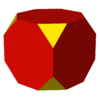 Truncated cube Truncated cube In geometry, the truncated cube, or truncated hexahedron, is an Archimedean solid. It has 14 regular faces , 36 edges, and 24 vertices.... |
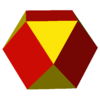 Cuboctahedron Cuboctahedron In geometry, a cuboctahedron is a polyhedron with eight triangular faces and six square faces. A cuboctahedron has 12 identical vertices, with two triangles and two squares meeting at each, and 24 identical edges, each separating a triangle from a square. As such it is a quasiregular polyhedron,... |
 Truncated octahedron Truncated octahedron In geometry, the truncated octahedron is an Archimedean solid. It has 14 faces , 36 edges, and 24 vertices. Since each of its faces has point symmetry the truncated octahedron is a zonohedron.... |
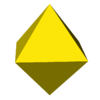 Octahedron Octahedron In geometry, an octahedron is a polyhedron with eight faces. A regular octahedron is a Platonic solid composed of eight equilateral triangles, four of which meet at each vertex.... |
| [5,3] |  Dodecahedron |
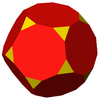 Truncated dodecahedron Truncated dodecahedron In geometry, the truncated dodecahedron is an Archimedean solid. It has 12 regular decagonal faces, 20 regular triangular faces, 60 vertices and 90 edges.- Geometric relations :... |
 Icosidodecahedron Icosidodecahedron In geometry, an icosidodecahedron is a polyhedron with twenty triangular faces and twelve pentagonal faces. An icosidodecahedron has 30 identical vertices, with two triangles and two pentagons meeting at each, and 60 identical edges, each separating a triangle from a pentagon... |
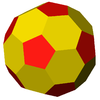 Truncated icosahedron Truncated icosahedron In geometry, the truncated icosahedron is an Archimedean solid, one of thirteen convex isogonal nonprismatic solids whose faces are two or more types of regular polygons.It has 12 regular pentagonal faces, 20 regular hexagonal faces, 60 vertices and 90 edges.... |
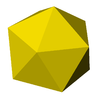 Icosahedron Icosahedron In geometry, an icosahedron is a regular polyhedron with 20 identical equilateral triangular faces, 30 edges and 12 vertices. It is one of the five Platonic solids.... |
| [6,3] |  Hexagonal tiling |
 Truncated hexagonal tiling Truncated hexagonal tiling In geometry, the truncated hexagonal tiling is a semiregular tiling of the Euclidean plane. There are 2 dodecagons and one triangle on each vertex.... |
 Trihexagonal tiling Trihexagonal tiling In geometry, the trihexagonal tiling is a semiregular tiling of the Euclidean plane. There are two triangles and two hexagons alternating on each vertex... |
 Hexagonal tiling |
 Triangular tiling |
| [7,3] |  Order-3 heptagonal tiling |
 Order-3 truncated heptagonal tiling Order-3 truncated heptagonal tiling In geometry, the Truncated order-3 heptagonal tiling is a semiregular tiling of the hyperbolic plane. There is one triangle and two tetrakaidecagons on each vertex... |
 Triheptagonal tiling Triheptagonal tiling In geometry, the triheptagonal tiling is a semiregular tiling of the hyperbolic plane, representing a rectified Order-3 heptagonal tiling. There are two triangles and two heptagons alternating on each vertex... |
 Order-7 truncated triangular tiling Order-7 truncated triangular tiling In geometry, the Order 7 truncated heptagonal tiling, sometimes called the hyperbolic soccerball, is a semiregular tiling of the hyperbolic plane. There are two hexagons and one heptagon on each vertex, forming a pattern similar to a conventional soccer ball with heptagons in place of pentagons... |
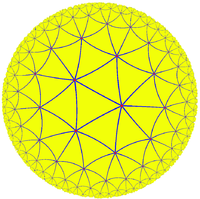 Order-7 triangular tiling |
| [8,3] |  Order-3 Octagonal tiling |
 Order-3 truncated Octagonal tiling |
 Trioctagonal tiling |
 Order-8 truncated triangular tiling |
 Order-8 triangular tiling |
| [4,4] |  Square tiling |
 Truncated square tiling Truncated square tiling In geometry, the truncated square tiling is a semiregular tiling of the Euclidean plane. There is one square and two octagons on each vertex. This is the only edge-to-edge tiling by regular convex polygons which contains an octagon... |
 Square tiling |
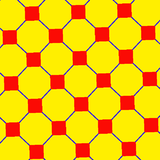 Truncated square tiling Truncated square tiling In geometry, the truncated square tiling is a semiregular tiling of the Euclidean plane. There is one square and two octagons on each vertex. This is the only edge-to-edge tiling by regular convex polygons which contains an octagon... |
 Square tiling |
| [5,4] |  pentagonal |
 truncated pentagonal |
 Rectified pentagonal |
 Truncated square |
 Square |
| [5,5] |  Pentagonal |
 Truncated pentagonal |
 Rectified pentagonal |
 Truncated pentagonal |
 Pentagonal |
Prismatic polyhedron examples
| Family | Original | Truncation | Rectification (And dual) |
|---|---|---|---|
| [2,p] |  Hexagonal hosohedron (As spherical tiling) {2,p} |
 Hexagonal prism Hexagonal prism In geometry, the hexagonal prism is a prism with hexagonal base. The shape has 8 faces, 18 edges, and 12 vertices.Since it has eight faces, it is an octahedron. However, the term octahedron is primarily used to refer to the regular octahedron, which has eight triangular faces... t{2,p} |
 Hexagonal dihedron Dihedron A dihedron is a type of polyhedron, made of two polygon faces which share the same set of edges. In three-dimensional Euclidean space, it is degenerate if its faces are flat, while in three-dimensional spherical space, a dihedron with flat faces can be thought of as a lens, an example of which is... (As spherical tiling) {p,2} |
rhombitruncated examples
These forms start with a rectifiedregular form which is truncated. The vertices are order-4, and a true geometric truncation would create rectangular faces. The uniform rhombitruction requires adjustment to create square faces.
| Original | Rectification | Rhombitruncation |
|---|---|---|
 |
 |
 Truncated octahedron Truncated octahedron In geometry, the truncated octahedron is an Archimedean solid. It has 14 faces , 36 edges, and 24 vertices. Since each of its faces has point symmetry the truncated octahedron is a zonohedron.... |
 |
 Cuboctahedron Cuboctahedron In geometry, a cuboctahedron is a polyhedron with eight triangular faces and six square faces. A cuboctahedron has 12 identical vertices, with two triangles and two squares meeting at each, and 24 identical edges, each separating a triangle from a square. As such it is a quasiregular polyhedron,... |
 Truncated cuboctahedron Truncated cuboctahedron In geometry, the truncated cuboctahedron is an Archimedean solid. It has 12 square faces, 8 regular hexagonal faces, 6 regular octagonal faces, 48 vertices and 72 edges... |
 |
 Icosidodecahedron Icosidodecahedron In geometry, an icosidodecahedron is a polyhedron with twenty triangular faces and twelve pentagonal faces. An icosidodecahedron has 30 identical vertices, with two triangles and two pentagons meeting at each, and 60 identical edges, each separating a triangle from a pentagon... |
 Truncated icosidodecahedron Truncated icosidodecahedron In geometry, the truncated icosidodecahedron is an Archimedean solid, one of thirteen convex isogonal nonprismatic solids constructed by two or more types of regular polygon faces.... |
 |
 Trihexagonal tiling Trihexagonal tiling In geometry, the trihexagonal tiling is a semiregular tiling of the Euclidean plane. There are two triangles and two hexagons alternating on each vertex... |
 Truncated trihexagonal tiling Great rhombitrihexagonal tiling In geometry, the truncated trihexagonal tiling is a semiregular tiling of the Euclidean plane. There are one square, one hexagon, and one dodecagon on each vertex... or great rhombitrihexagonal tiling |
 |
 Triheptagonal tiling Triheptagonal tiling In geometry, the triheptagonal tiling is a semiregular tiling of the hyperbolic plane, representing a rectified Order-3 heptagonal tiling. There are two triangles and two heptagons alternating on each vertex... |
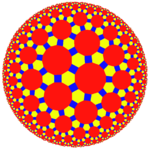 Truncated triheptagonal tiling or great rhombitriheptagonal tiling |
 |
 Trioctagonal tiling |
 Truncated trioctagonal tiling or great rhombitrioctagonal tiling |
 |
 Square tiling |
 Truncated square tiling Truncated square tiling In geometry, the truncated square tiling is a semiregular tiling of the Euclidean plane. There is one square and two octagons on each vertex. This is the only edge-to-edge tiling by regular convex polygons which contains an octagon... |
 |
 Tetrapentagonal tiling |
 Truncated tetrapentagonal tiling |
 |
 Order-4 pentagonal tiling |
 Order-4 truncated pentagonal tiling |
Truncation in polychora and honeycomb tessellation
A regular polychoron or tessellation {p,q,r}, truncated becomes a uniform polychoron or tessellation with 2 cells: truncated {p,q}, and {q,r} cells are created on the truncated section.See: uniform polychoron
and convex uniform honeycomb
.
| Family [p,q,r] |
Parent | Truncation | Rectification (birectified dual) |
Bitruncation (bitruncated dual) |
|---|---|---|---|---|
| [3,3,3] | 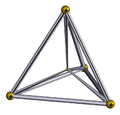 5-cell (self-dual) |
 truncated 5-cell Truncated 5-cell In geometry, a truncated 5-cell is a uniform polychoron formed as the truncation of the regular 5-cell.There are two degrees of trunctions, including a bitruncation.- Truncated 5-cell:... |
 rectified 5-cell Rectified 5-cell In four dimensional geometry, the rectified 5-cell is a uniform polychoron composed of 5 regular tetrahedral and 5 regular octahedral cells. Each edge has one tetrahedron and two octahedra. Each vertex has two tetrahedra and three octahedra. In total it has 30 triangle faces, 30 edges, and 10... |
 bitruncated 5-cell |
| [3,3,4] |  16-cell 16-cell In four dimensional geometry, a 16-cell or hexadecachoron is a regular convex 4-polytope. It is one of the six regular convex 4-polytopes first described by the Swiss mathematician Ludwig Schläfli in the mid-19th century.... |
 truncated 16-cell |
 rectified 16-cell (Same as 24-cell) |
 bitruncated 16-cell (bitruncated tesseract) |
| [4,3,3] | 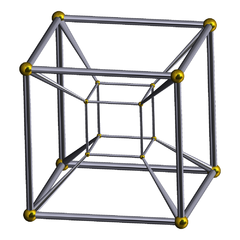 Tesseract Tesseract In geometry, the tesseract, also called an 8-cell or regular octachoron or cubic prism, is the four-dimensional analog of the cube. The tesseract is to the cube as the cube is to the square. Just as the surface of the cube consists of 6 square faces, the hypersurface of the tesseract consists of 8... |
 truncated tesseract Truncated tesseract In geometry, a truncated tesseract is a uniform polychoron formed as the truncation of the regular tesseract.There are three trunctions, including a bitruncation, and a tritruncation, which creates the truncated 16-cell.... |
 rectified tesseract Rectified tesseract In geometry, the rectified tesseract, or rectified 8-cell is a uniform polychoron bounded by 24 cells: 8 cuboctahedra, and 16 tetrahedra.... |
 bitruncated tesseract (bitruncated 16-cell) |
| [3,4,3] | 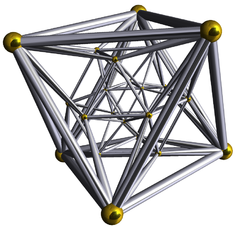 24-cell (self-dual) |
 truncated 24-cell Truncated 24-cell In geometry, a truncated 5-cell is a uniform polychoron formed as the truncation of the regular 5-cell.There are two degrees of trunctions, including a bitruncation.- Truncated 5-cell:... |
 rectified 24-cell Rectified 24-cell In geometry, the rectified 24-cell is a uniform 4-dimensional polytope , which is bounded by 48 cells: 24 cubes, and 24 cuboctahedra. It can be obtained by reducing the icositetrachoron's cells to cubes or cuboctahedra.... |
bitruncated 24-cell |
| [3,3,5] | 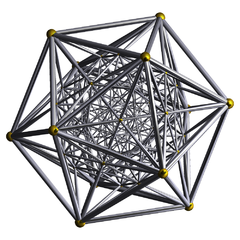 600-cell |
 truncated 600-cell |
rectified 600-cell Rectified 600-cell In geometry, a rectified 600-cell is a uniform polychoron formed as the rectification of the regular 600-cell.There are four rectifications of the 600-cell, including the zeroth, the 600-cell itself... |
bitruncated 600-cell (bitruncated 120-cell) |
| [5,3,3] | 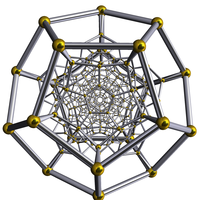 120-cell |
 truncated 120-cell Truncated 120-cell In geometry, a truncated 120-cell is a uniform polychoron formed as the truncation of the regular 120-cell.There are three trunctions, including a bitruncation, and a tritruncation, which creates the truncated 600-cell.... |
 rectified 120-cell Rectified 120-cell In geometry, a rectified 120-cell is a uniform polychoron formed as the rectification of the regular 120-cell.There are four rectifications of the 120-cell, including the zeroth, the 120-cell itself... |
|
| [4,3,4] |  cubic Cubic honeycomb The cubic honeycomb is the only regular space-filling tessellation in Euclidean 3-space, made up of cubic cells. It has 4 cubes around every edge, and 8 cubes around each vertex. Its vertex figure is a regular octahedron.... (self-dual) |
 truncated cubic Truncated cubic honeycomb The truncated cubic honeycomb is a uniform space-filling tessellation in Euclidean 3-space. It is composed of truncated cubes and octahedra in a ratio of 1:1.- Symmetry :... |
 rectified cubic Rectified cubic honeycomb The rectified cubic honeycomb is a uniform space-filling tessellation in Euclidean 3-space. It is composed of octahedra and cuboctahedra in a ratio of 1:1.- Symmetry :... |
 bitruncated cubic Bitruncated cubic honeycomb The bitruncated cubic honeycomb is a space-filling tessellation in Euclidean 3-space made up of truncated octahedra.It is one of 28 uniform honeycombs. It has 4 truncated octahedra around each vertex.... |
| [3,5,3] |  icosahedral (self-dual) |
(No image) truncated icosahedral |
(No image) rectified icosahedral |
(No image) bitruncated icosahedral |
| [4,3,5] |  cubic |
(No image) truncated cubic |
(No image) rectified cubic |
(No image) bitruncated cubic (bitruncated dodecahedral) |
| [5,3,4] |  dodecahedral |
(No image) truncated dodecahedral |
(No image) rectified dodecahedral |
|
| [5,3,5] | (No image) dodecahedral (self-dual) |
(No image) truncated dodecahedral |
(No image) rectified dodecahedral |
(No image) bitruncated dodecahedral |
See also
- uniform polyhedronUniform polyhedronA uniform polyhedron is a polyhedron which has regular polygons as faces and is vertex-transitive...
- uniform polychoronUniform polychoronIn geometry, a uniform polychoron is a polychoron or 4-polytope which is vertex-transitive and whose cells are uniform polyhedra....
- Bitruncation (geometry)
- Rectification (geometry)Rectification (geometry)In Euclidean geometry, rectification is the process of truncating a polytope by marking the midpoints of all its edges, and cutting off its vertices at those points...
- Alternation (geometry)
- Conway polyhedron notationConway polyhedron notationConway polyhedron notation is used to describe polyhedra based on a seed polyhedron modified by various operations.The seed polyhedra are the Platonic solids, represented by their first letter of their name ; the prisms , antiprisms and pyramids...

